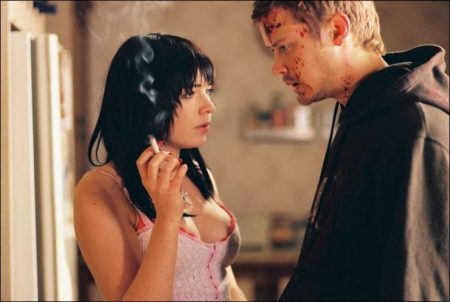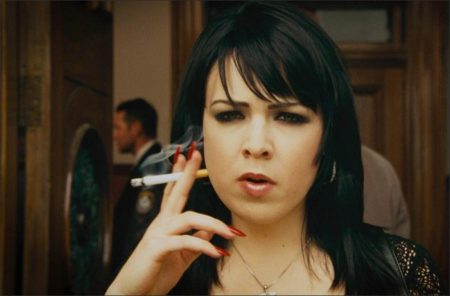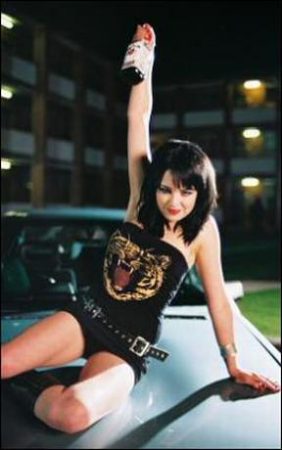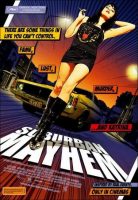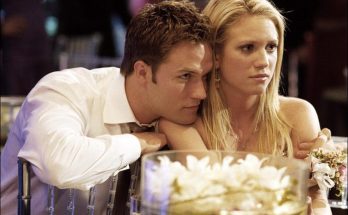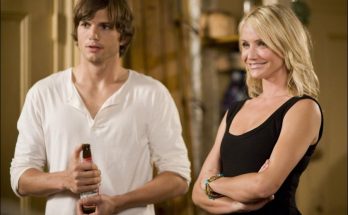About the Production
While every good film begins with a good script, the screenplay for Suburban Mayhem – the work of the precociously talented first-time screenwriter Alice Bell – has evoked the kind of praise that announces the arrival of a major new cinema talent.
Mark Gooder, CEO of Icon Films, the distributor in Australia and New Zealand, said: “Even an experienced script writer would be hard-pressed to match Alice’s screenplay for its sheer entertainment and originality. At the heart of Suburban Mayhem is a central character so remarkable and audacious that she takes your breath away. There’s an energy about this project that continues to excite all of those involved with it.”
Producer Leah Churchill-Brown said: “We have pulled together a superb cast and crew, and our investors have all been enthusiastic collaborators. I believe it’s because our writer, Alice Bell has written such a chillingly authentic and fresh screenplay, that everyone we’ve approached has wanted to join us on the mayhem roller coaster ride.”
Paul Goldman, who began as a script editor on the project but quickly signed up as director, said: “It’s been an exciting film from the day I turned the first page.”
Suburban Mayhem stars New Zealand’s award winning actress Emily Barclay (last seen in the critically acclaimed film In My Father’s Den) as a wild, conniving and dangerously compelling single mother. Michael Dorman (from the hit television series The Secret Life Of Us) is her besotted boyfriend. Other cast include Anthony Hayes (The Boys), Genevieve Lemon (The Piano), Steve Bastoni, Robert Morgan, Laurence Breuls and newcomer Mia Wasikowska.
Suburban Mayhem is distributed in Australia and New Zealand by Icon Film Distribution. Fortissimo Films is the international sales agent. Investors are the Film Finance Corporation Australia, the New South Wales Film & Television Office and PMP Showtime.
Development
Jan Chapman, whose films as producer include the Academy-Award winning The Piano, Lantana, The Last Days of Chez Nous and Love Serenade, is Executive Producer of Suburban Mayhem. It is only the second film she has executive produced and follows the multi-award winning Somersault.
“I started to want to help less experienced producers to get their films to happen and around that time Leah and Paul came to see me and they told me about the script which I later read on a plane. I was just so involved with the story, and finding it so funny and amusing, that I didn’t want the plane trip to finish,” Jan says.
“I was very enchanted by it, I thought it was a great tale. Then I met Alice and understood where this fresh young voice came from. We did quite a lot of work on the script to make sure that every scene contributed to the ride. It is the kind of film where you can’t have extraneous stuff, you have to be totally engaged. I’ve always thought about our audience being open-mouthed in anticipation of what’s going to happen next!”
The film began with an idea by Leah Churchill-Brown. Leah is renowned as one of Australia’s best producers of commercials and music videos, and earlier in her career was associate producer of the Academy Award nominated documentaries Nicaragua: No Pasaran and Chile: Hasta Cuando, but was keen to branch out into feature films. She was working with a journalist to develop a script about a domestic crime, but the idea didn’t work out. Then she discovered that Alice Bell, who’d worked with her as a production co-ordinator for six years, had started to write her own script.
“I didn’t even know Alice was a writer, other than that she would go on holidays and write hysterical emails. But Alice and I love a tabloid newspaper, we share the same black humour and we both love to read a good crime story. It seemed to us that ever since the days of the Menendez brothers and more recently.
Sef Gonzales in Sydney, there have been a series of terrible crimes in families. That fascinated me because I come from a very happy, normal family,” Leah explains.
“I became obsessed with the idea of nature versus nurture. Does evil exist or does it have to be a crime of passion? Alice started to write ideas down and a year later, with Alice beavering at home at nights and us spending weekends together watching thousands of films, we had a script.”
Early in the process, Leah showed their ideas to her mentor on another project, the well known Australian producer/director Robert Connolly. His use of the word `naughty’ inspired Leah and Alice to continue with a script that treaded a fine line between humour and dark drama and to create one of the most arresting central characters ever in an Australian film, Katrina Skinner.
During the development process, Alice was advised that Katrina needed to have something in her background to excuse her bad behaviour. Alice pushed back, determined to create a surprising and original screenplay:
“The film, and Katrina, are not apologetic. It seems that in `script writing law’ you have to give reasons; i.e. what had Katrina’s father done to her, but I didn’t want this to be like other films, tied up as a neat little package. I wanted audiences to walk away at the end saying `wow she got away with it’, so I purposefully planted lots of story lines and characters that go up against each other, because the best thing that could happen for me as a writer would be for people to be arguing as they left the cinema and asking questions. Was she abused? Who is the father of Bailee? What did happen between Andretti and Katrina? That’s what small town gossip is like. I want audiences to have their own opinions about what really happened in Golden Grove… ,” Alice says.
Production of the film coincided with the assault on New Orleans by Cyclone Katrina; and not for the first time, cast and crew described said of their lead character: “Katrina is a force of nature.”
Alice Bell had a huge collection of newspaper clippings about crimes within families and was clear that she wanted to write a film that explored an awful event within a family – and she wanted the protagonist to get away with it.
“To do that I had to come up with a character who was probably a version of myself if I had taken away all the boundaries you get growing up. I took characteristics from different murderers and I took away all of society’s boundaries and any concerns for consequences, and that’s how I created the idea of Katrina,” Alice says. “Once I had the character, I threw her into the middle of suburbia, I gave her a baby – because it was such a nice contrast to what she was about to do in the film – and then Katrina wrote herself. She’s a character who just doesn’t stop.
“I had always thought of Katrina as a hurricane. It is easy to talk about the terrible things Katrina does, but what I like about her is that she is so exciting. She’s terrifying to watch but she’s also the person you’d rather be with than not `cause otherwise the party is pretty dull. She is alive. She may not be living life the way we all would, but she’s definitely having a better time. She has a lot of wit. She says things that no one else would ever dare to say and that’s why she is so funny.”
Jan Chapman describes Katrina as a girl with a strong sense of her own entitlement. When Katrina is thwarted by her father who finally stops giving her everything that she wants, she enrols everyone around her in her wicked scheme.
“The film is a wild ride, a ride of madness, energy, power, wickedness, but it is mainly about someone who has no boundaries and I think it is exciting for people to watch someone with no boundaries; it’s like that vicarious part of yourself that you’d like to be able to indulge a little bit,” Jan says.
Director Paul Goldman had made two feature films – Australian Rules and The Night We Called it a Day – and was also well known for his work in music videos and television commercials. He’d worked closely with both Leah and Alice for several years when Alice showed him the script at first draft stage.
“I had just finished making a film where I was a gun for hire. I had been asked to direct the film in which I had had no involvement in the development, so I’d just been through that experience and it hadn’t been a happy one for me. Then, in the last bit of post-production I read Suburban Mayhem. Clearly already it was a screenplay with a very strong voice, it had a very, very strong character, and I saw potential for taking it in some directions that would be very interesting to me. I wanted to do a project where I was engaged by the characters and by the principal people around me. I had had a long association with both Alice and Leah and I knew I could trust them and that they were exciting people to be around,” Paul says.
Paul script edited with Alice for a year, bringing his own perspective and ideas to the story: “I think it was understood implicitly by Alice and Leah that I wanted to make the whole tone of the film a lot darker and of course Alice always wanted to guard the integrity of the humour of the film. Any creative conflict over the two and a half years of development came out of my insistence that the film be absolutely anchored in emotional and psychological truth; I guess I like stories that are dark… I like the underbelly.”
“I didn’t want the film to descend into farce. There are lots of black comedic moments in this film, the humour of it is very, very important, but it was always going to be a fine line; I didn’t want it to become Kath & Kim or Sylvania Waters, or too knowingly self-conscious.”
Casting
Casting the role of Katrina was an obvious challenge. It was clear that Suburban Mayhem would sink or swim on that one casting. Paul chose as casting director Anousha Zarkesh with whom he’d worked on his previous two features. They were committed to a long casting process, which is Paul’s preferred modus operandi.
“Anousha knew that I was never going to have any `eureka’ moments. I never sit there and say `wow I’ve found the character’. I tend to tease myself and tease the whole discussion out. We saw a lot of girls and we saw a lot of good actresses. Emily’s name had been floating around ever since we’d seen her in
In My Father’s Den 18 months before we started casting. I always had my doubts and spent a lot of time convincing everyone else that Emily wasn’t the right person, but there was some quality about her which meant that strangely she was always in contention. To Jan Chapman’s credit and to my eternal gratitude Jan insisted that we keep going back to Emily. We got her back from New Zealand for an audition and she just blew us all away. It was so obvious that she was the girl we’d been looking for. She is amazing in the film so it`s strange to think we had doubts about her.”
Alice Bell and Emily Barclay quickly became close friends – in fact, Emily could almost be Alice’s doppelganger – and they spent a lot of time hanging out together on set.
“Emily is perfect to play Katrina. She’s sassy, funny, intelligent and a little bit crazy. She has an intensity that I haven’t seen before. She’s a rare find and her performance brought out so much in the other actors. I think everyone was racing to meet her. Sometimes I had to remind myself during the shoot that she was Emily not Katrina – she really inhabited the role,” Alice says.
Emily Barclay is supported by a superb ensemble cast including another relative newcomer, Michael Dorman, as her devoted boyfriend Rusty.
Producer Leah Churchill Brown says: “We called Michael back for a second audition and got him to do the sex scene. I saw in that moment that not only is he a hunk but your heart just goes out to him as Rusty. He has a softness in his performance which is the perfect antidote to Katrina, you believe in him fully and you can understand why he does what he does. It was critical for the actor to be able to get that balance.”
Rehearsals
Paul Goldman is noted for his perfectionist drive and attention to detail. Part of the process he’s developed over three films is to have actor David Field work with him and the actors throughout an intense rehearsal period. For six to ten hours a day for 13 days they worked together with the actors filling in back stories, creating a social milieu, and using various techniques to, Paul says, “load the actors up”. Rehearsals took place at the pre-production office so the door was open for crew to wander in and participate. The writer Alice Bell was also there.
“David’s a close friend and colleague and we have a very detailed understanding of what we want to achieve in rehearsals, I throw the rehearsal room open to David to do what he likes. David followed the development of this project as his partner Anousha was casting the film, and throughout that period we’d just keep talking about what we wanted to achieve and he’d keep checking with me about where my ideas were going. There’s always a very, very rich dialogue between David and me and the reason I have him there is because he is fearless in the rehearsal room,” Paul says.
“I like our rehearsals to be very `impro’ based and that can definitely become very indulgent, and sometimes even destructive in less capable hands. But David’s just so focused, he’s so demanding, he’s also got a wonderful way of encouraging people. He’s an amazingly generous person and he leaves everyone thinking that anything is possible. His contribution to the three films I’ve made is invaluable.
“It was an exhilarating time for all the cast, but especially for our young actors Emily, Michael and Mia Wasikowska.”
An interesting example of Paul’s technique with actors is his approach to the character of Aunty Dianne, played by Genevieve Lemon, who is essentially the narrator of the story. Her character speaks directly to camera in a series of interviews looking back on the events depicted in the film. Paul was aware of the danger of turning the character into a parody or stereotype.
“I’d given Genevieve a few films to watch, for example, I made her watch a couple of episodes of Sylvania Waters and the documentary Cunnamulla. We spent a lot of time in rehearsals with the interviews. They aspire to be real and to have all the resonance of real time direct to camera interviews. Aunty Dianne has to go to quite a few places emotionally and so I thought the best way to load her up before we started was to ask Robert Morgan, who plays John, Katrina’s father, and who is very, very close to Aunty Dianne, on the last day of his rehearsals – do a video taped birthday message to Aunty Dianne.
“We got in a cake and some candles. This was meant to be a surprise gift that John was going to give Dianne for her birthday… but unfortunately in the meantime he’d been killed. So on the day we were shooting Genevieve’s scenes we played her the tape, which she had no idea about, and I think it was fantastic for her. So they are the kinds of things I like doing in rehearsals and the kind of preparation I like for actors.
“I insist that people get very, very involved and use their imaginations; that goes a long way to really focusing people and myself as well.”
The technique of using interviews and flashbacks was one that Alice, Leah and Paul all had to fight for: “I had admired the technique in To Die For but a lot of people told us that the interviews were just dead time, whereas I think they give a real insight into characters as you get to see their various perspectives,” Alice says.
Suburban Mayhem (2006)
Directed by: Paul Goldman
Starring: Emily Barclay, Michael Dorman, Anthony Hayes, Steve Bastoni, Mia Wasikowska, Genevieve Lemon, Robert Morgan, Susan Prior, Christine Armstrong, Philippe Ayoub
Screenplay by: Alice Bell
Production Design by: Nell Hanson
Cinematography by: Robert Humphreys
Film Editing by: Stephen Evans
Costume Design by: Melinda Doring
Set Decoration by: Richie Dehne
Art Direction by: Janie Parker
Music by: Mick Harvey
MPAA Rating: R for pervasive strong crude and sexual content including graphic nudity, and language.
Distributed by: Icon Film Distribution
Release Date: October 26, 2006
Visits: 118
